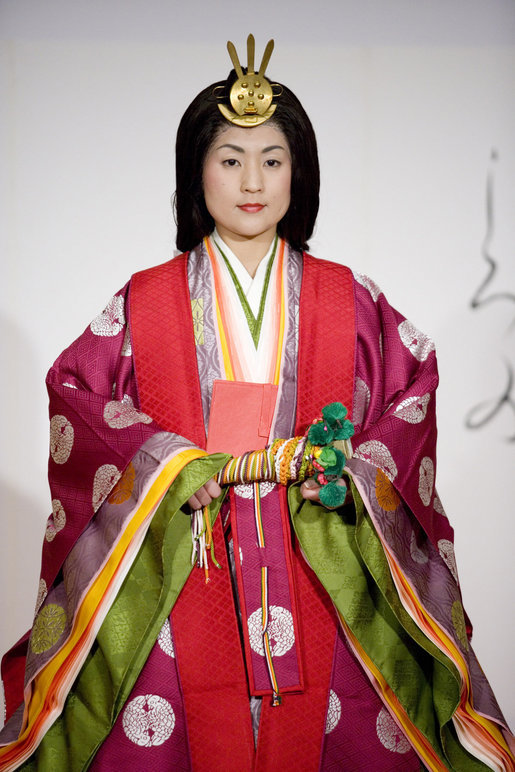|
Suetsumuhana
is the archaic Japanese word for the safflower. It is known now as . Character in The Tale Of Genji Suetsumuhana is the name of a female character in Murasaki Shikibu's epic novel '' The Tale of Genji''. The sixth chapter of it is named after her. She is also known as the Safflower Princess. In some English translations she appears as Princess Hitachi. Prince Genji was briefly attracted to her, until she lowered her fan to reveal her nose. However, he eventually felt sorry for her and helped support her. She is noted to be one of the most loyal ladies in the ''Tale of Genji'', pining and waiting for Genji till he reciprocates her love. This is in part due to her unending loyalty to him, and that he is her first, and possibly, last man. She is invited to the palace, known also as the "Palace in the Sixth Ward", that Genji has built for all his women, and is taken care of for the rest of her life. The incident with the Safflower Princess's nose has always been a source of ... [...More Info...] [...Related Items...] OR: [Wikipedia] [Google] [Baidu] |
The Tale Of Genji
is a classic work of Japanese literature written by the noblewoman, poet, and lady-in-waiting Murasaki Shikibu around the peak of the Heian period, in the early 11th century. It is one of history's first novels, the first by a woman to have won global recognition, and in Japan today has a stature like that of Shakespeare in England. The work is a depiction of the lifestyles of high courtiers during the Heian period. It is written mostly in Japanese phonetic script (''hiragana''), in a vernacular style associated with women's writing of the time (not the same as "vernacular Japanese", which only appeared in late 19th century), not in Chinese characters (''kanji'') used for more prestigious literature, and its archaic language and poetic style require specialised study. The original manuscript no longer exists but there are more than 300 later manuscript copies of varying reliability. It was made in "Folded leaflet#Concertina fold, concertina" or style: several sheets of paper p ... [...More Info...] [...Related Items...] OR: [Wikipedia] [Google] [Baidu] |
Safflower
Safflower (''Carthamus tinctorius'') is a highly branched, herbaceous, thistle-like annual plant in the family Asteraceae. It is one of the world's oldest crops; today, it is commercially cultivated for vegetable oil extracted from the seeds. Plants are tall with globular flower heads having yellow, orange, or red flowers. Each branch will usually have from one to five flower heads containing 15 to 20 seeds per head. Safflower is native to arid environments having seasonal rain. It grows a deep taproot which enables it to thrive in such environments. Biology Plant morphology Safflower is a fast growing, erect, winter/spring-growing annual herb, that resembles a thistle. Originating from a leaf rosette emerges a branched central stem (also referred to as terminal stem), when day length and temperature increase. The main shoot reaches heights of . The plant also develops a strong taproot, growing as deep as . First lateral branches develop, once the main stem is about ... [...More Info...] [...Related Items...] OR: [Wikipedia] [Google] [Baidu] |
Window Screen
A window screen (also known as insect screen, bug screen, fly screen, flywire, wire mesh, or window net) is designed to cover the opening of a window. It is usually a mesh made of metal, fibreglass, plastic wire, or other pieces of plastic and stretched in a frame of wood or metal. It serves to keep leaves, debris, bugs, birds, and other animals from entering a building or a screened structure such as a porch, without blocking fresh air-flow. Most houses in Australia, the United States and Canada and other parts of the world have screens on windows to prevent entry of flying insects such as mosquitoes, flies and wasps. In some regions such as the northern United States and Canada, screens were required to be replaced by glass storm windows in the winter, but now combination storm and screen windows are available, which allow glass and screen panels to slide up and down. For screens installed on aluminium frames, the material is cut slightly larger than the frame, then lai ... [...More Info...] [...Related Items...] OR: [Wikipedia] [Google] [Baidu] |
Obscene
An obscenity is any utterance or act that strongly offends the prevalent morality of the time. It is derived from the Latin , , "boding ill; disgusting; indecent", of uncertain etymology. Generally, the term can be used to indicate strong moral repugnance and outrage in expressions such as "obscene profits" and "the obscenity of war". As a legal term, it usually refers to descriptions and depictions of people engaged in sexual and excretory activity. United States obscenity law In the United States, issues of obscenity raise issues of limitations on the freedom of speech and of the press, which are otherwise protected by the First Amendment to the U.S. Constitution. Federal obscenity law in the U.S. is unusual in that there is no uniform national standard. Former Justice Potter Stewart of the Supreme Court of the United States, in attempting to classify what material constituted exactly "what is obscene", famously wrote, "I shall not today attempt further to define t ... [...More Info...] [...Related Items...] OR: [Wikipedia] [Google] [Baidu] |
Elephant
Elephants are the largest living land animals. Three living species are currently recognised: the African bush elephant ('' Loxodonta africana''), the African forest elephant (''L. cyclotis''), and the Asian elephant ('' Elephas maximus''). They are the only surviving members of the family Elephantidae and the order Proboscidea; extinct relatives include mammoths and mastodons. Distinctive features of elephants include a long proboscis called a trunk, tusks, large ear flaps, pillar-like legs, and tough but sensitive grey skin. The trunk is prehensile, bringing food and water to the mouth and grasping objects. Tusks, which are derived from the incisor teeth, serve both as weapons and as tools for moving objects and digging. The large ear flaps assist in maintaining a constant body temperature as well as in communication. African elephants have larger ears and concave backs, whereas Asian elephants have smaller ears and convex or level backs. Elephants are scatter ... [...More Info...] [...Related Items...] OR: [Wikipedia] [Google] [Baidu] |
Sleeve
A sleeve (, a word allied to '' slip'', cf. Dutch ) is the part of a garment that covers the arm, or through which the arm passes or slips. The sleeve is a characteristic of fashion seen in almost every country and time period, across a myriad of styles of dress. Styles vary from close-fitting to the arm, to relatively unfitted and wide sleeves, some with extremely wide cuffs. Long, hanging sleeves have been used variously as a type of pocket, from which the phrase "to have up one's sleeve" (to have something concealed ready to produce) comes. There are many other proverbial and metaphorical expressions associated with the sleeve, such as "to wear one's heart upon one's sleeve", and "to laugh in one's sleeve". Early Western medieval sleeves were cut straight, and underarm triangle-shaped gussets were used to provide ease of movement. In the 14th century, the rounded sleeve cap was invented, allowing a more fitted sleeve to be inserted, with ease around the sleeve head and a ... [...More Info...] [...Related Items...] OR: [Wikipedia] [Google] [Baidu] |
Heian Period
The is the last division of classical Japanese history, running from 794 to 1185. It followed the Nara period, beginning when the 50th emperor, Emperor Kammu, moved the capital of Japan to Heian-kyō (modern Kyoto). means in Japanese. It is a period in Japanese history when the Chinese influence on Japanese culture, Chinese influences were in decline and the national culture matured. The Heian period is also considered the peak of the Japanese Emperors of Japan, imperial court, noted for its Japanese art, art, especially Japanese poetry, poetry and Japanese literature, literature. Two syllabaries unique to Japan, katakana and hiragana, emerged during this time. This gave rise to Japan's famous vernacular literature, with many of its texts written by court ladies who were not as educated in Chinese as their male counterparts. Although the Imperial House of Japan had power on the surface, the real power was in the hands of the Fujiwara clan, a powerful Kuge, aristocratic family wh ... [...More Info...] [...Related Items...] OR: [Wikipedia] [Google] [Baidu] |
Koto (musical Instrument)
The is a Japanese plucked half-tube zither instrument, and the national instrument of Japan. It is derived from the Chinese and , and similar to the Mongolian , the Korean and , the Vietnamese , the Sundanese and the Kazakh . Koto are roughly in length, and made from Paulownia wood ('' Paulownia tomentosa'', known as ). The most common type uses 13 strings strung over movable bridges used for tuning, different pieces possibly requiring different tuning. Seventeen-string koto are also common, and act as bass in ensembles. Koto strings are generally plucked using three fingerpicks (), worn on the first three fingers of the right hand. Names and types The character for ''koto'' is , although is often used. However, (''koto'') is the general term for all string instruments in the Japanese language,(jaKotobank koto/ref> including instruments such as the , , , , , and so on. When read as , it indicates the Chinese instrument . The term is used today in the same way. Th ... [...More Info...] [...Related Items...] OR: [Wikipedia] [Google] [Baidu] |
Sudare
are traditional Japanese screens or blinds, made of horizontal slats of decorative wood, bamboo, or other natural material, woven together with simple string, colored yarn, or other decorative material to make nearly solid blinds can be either rolled or folded up out of the way. They are also sometimes called , particularly if they have a green fabric hem. , non-hanging , are made of vertical slats of common reed and used as screen. are used in many Japanese homes to shield the verandah and other openings of the building from sunlight, rain, and insects. They are normally put up in spring and taken down again in autumn. Their light structure allows breezes to pass through, a benefit in the hot Japanese summers. Since the building materials are easy to find, can be made cheaply. Elaborate for palaces and villas used high-quality bamboo, with expensive silk and gold embroidery worked in. Sometimes they featured paintings, most often on the inside; some Chinese screens h ... [...More Info...] [...Related Items...] OR: [Wikipedia] [Google] [Baidu] |
Jūnihitoe
The , more formally known as the , is a style of formal court dress first worn in the Heian period by noble women and Lady-in-waiting, ladies-in-waiting at the Japanese Imperial Court. The was composed of a number of kimono-like robes, layered on top of each other, with the outer robes cut both larger and thinner to reveal the layered garments underneath. These robes were referred to as , with the innermost robe – worn as underwear against the skin – known as the . were also worn as underwear with the ; over time, the two would gradually become outerwear, with the eventually developing into the modern-day kimono. Despite the name, the varied in its exact number of layers. It also featured an (belt), though unlike modern version, this was little more than a thin, cordlike length of fabric. The number of layers, and the type of layers, could alter the formality of a outfit, with some accessories, such as overcoats and a long, skirt-like train (known as the ) only worn for ... [...More Info...] [...Related Items...] OR: [Wikipedia] [Google] [Baidu] |







